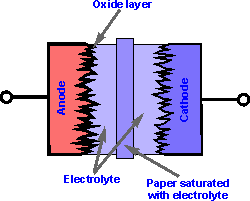Construction:
- The electrolytic capacitor consists of a metal foil electrode with oxide film grown over it. The thin oxide layers act as dielectric.
- It is surrounded by conducting electrolyte, which is form in a paste, it also in a liquid form. Anode is as the positive plate where the foil deposited with metal oxide.
- The negative plate of the electrolyte is act as cathode. For making electrical contact between one of the terminals and the electrolyte, another layer of metal foil without the oxide coating metal oxide is also provided.
- Gauge saturated with an electrolyte or oxide film is in contact with a paper. The whole assembly is packed in a metal cylinder.
- In order to insulate it from outside, the cylinder is usually enclosed in a paper tube or card board tube.
- The capacitor has large capacitance in a small volume because of thin metal oxide layer. It is design for use in circuits, where only DC voltages applied across the capacitor. The electrolytic capacitors are not useful for alternating current (AC). It has high capacitance to size ratio.
- The metal foil or metal oxide layers form a semiconductor i.e. the electrolytic capacitors are polarized in nature.
- This semiconductor blocks current coming to the metal oxide film towards the electrode, but it rapidly passes current in opposite direction. Properly connect the capacitor so that the applied voltage encounters the high resistance.

